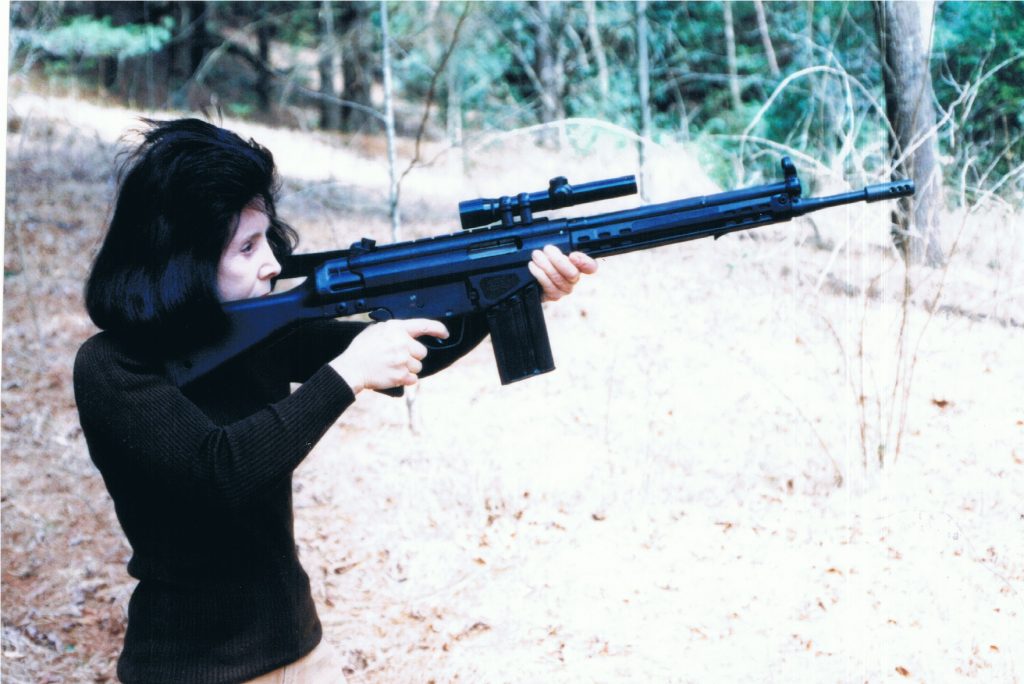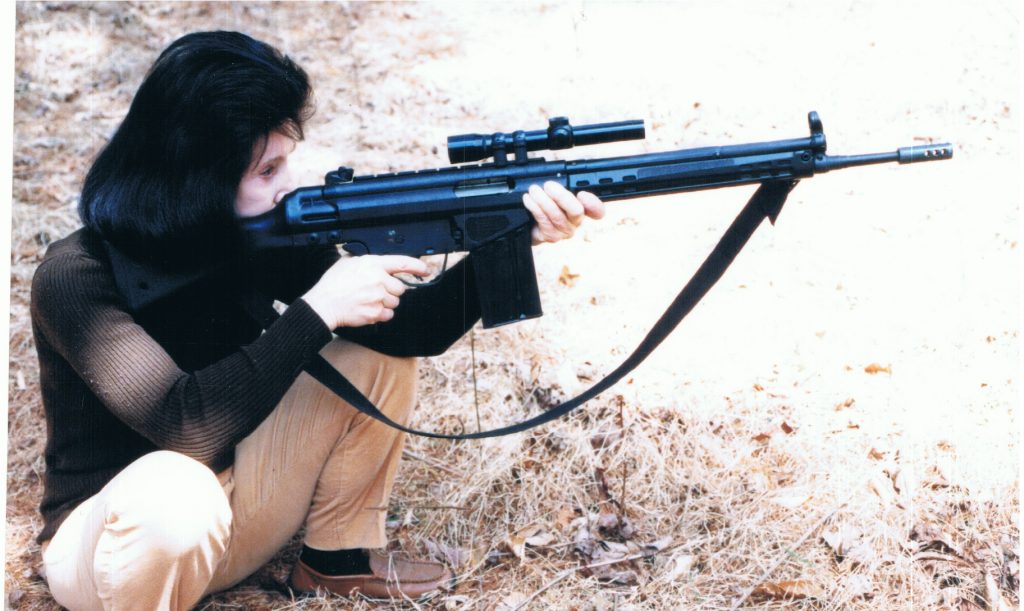By Jim Dickson | Contributing Editor

There are only three ways to learn to shoot: Shooting, shooting, and more shooting.
People get upset if you take a pistol in one hand and hit targets smaller and further than they can hit with a rifle but it’s all a matter of practice. Personally, I like to shoot a minimum of 200 rounds through a pistol each day and I have been known to shoot a thousand rounds a day when the ammo was available. Anyone that shoots that much is going to hit when he fires whereas Little Joe from Kokomo who only fires his rifle once a year before hunting season is going to be seriously embarrassed by his misses.
The person who shoots a steady string at the range ends up with a rifle sighted in to shoot from a hot barrel. Hot barrels often shoot to a different point of aim than cold barrels. When you shoot at a deer you are firing from a cold barrel and you may easily miss. The correct way is to shoot no more than three shots then open the bolt and let it cool before firing any more so the barrel does not heat up.
In addition to merely changing the point of the bullet’s impact a hot barrel often walks its shots as it deforms and bends under the heat from pre-existing stresses in the barrel. When it cools back down it goes back to the original point of impact. Unless you are a hopeless Sad Sack of a Private Snafu who is always going to miss and just needs an excuse you have to take these things into consideration.
There is a way to completely eliminate the variations of point of impact between hot and cold barrels so that the gun always shoots to the same point of impact no matter what. That method is to cryogenically treat the barrel and metal parts of the gun. The metal will be cycled down to 300 degrees below zero and then up to 300 degrees above zero. All stresses that cause barrels to warp under heat are removed, any minute internal structures that did not fully heat treat to the stronger form during heat treatment will complete their transition. The lifespan of the parts will be increased anywhere from 300 % to 1000% depending on the part.
Microscopic pores in the metal that trap powder fouling and make gun cleaning drag on and on are filled with precipitates so the metal now cleans like it was made of glass. The first patch through the bore now comes out incredibly filthy, the next almost clean, and the third clean. I like that. I have a long history with cryogenic treating of metal and the firm I recommend is Diversified Cryogenics. Contact Mark Link at 888-323-8456 and ship him your guns minus any plastic or wood parts as 300 degrees above can destroy them fast. Some low temperature solders on barrel ribs will take 300 degrees and others will melt.
Some years ago I reported in Gun Week on a semi-auto G3 I had. Originally it was not very accurate so I recrowned the barrel, put in a tighter bolt, and had it cryogenically treated. It now will only shoot ¾ inch groups at 100 yards. It doesn’t matter if the barrel is stone cold on a below freezing day or if I have fired it so many times that the oil is burning off the outside of the barrel. The groups size is always ¾ inch at 100 yards. Cleaning is a breeze now and that includes the muzzle brake which was made out of such porous metal that I originally had to swish it around in a jar of gasoline to clean it as it kept bleeding powder fouling. After cryogenic treatment it cleans like it was made of glass also.
Practice is what makes a shooter and the muscles involved need practice also. Just because your muscles are in shape does not make them steady for shooting. They have to be trained to be steady.
I take the aforementioned G3 and hold it on target offhand until I get shaky. With a Scout Scope and loaded 20 round magazine this gun weighs 12 pounds. That’s a good thing as light rifles are hard to hold on target when you are tired and out of breath as when running after game in Africa. That’s why you see so few rifles under 10 or 11 pounds from the glory days of African hunting with many of even the smaller caliber guns weighing even more. Weight is not just for recoil absorption; it is a major factor in holding a rifle steady. The U.S. Army once determined that a 16 ½-pound rifle was the steadiest of all. That was a bit hard to carry so they halved the weight when they adopted the 8 ¼ pound M1903 Springfield. “Sporterizing” this gun not only makes it kick it makes it unsteady.
You can also get the effect of weight without having to carry the extra pounds if you use a long barreled trapdoor Springfield or a long barreled pre-WW1 bolt action as the leverage of the long barrel works like weight. They also are more pleasant to shoot as the muzzle blast is farther away.
Do not fall for the myth that you absolutely must have a scope or at least a peep sight on your gun. A scope is nice but it’s magnification is its main advantage enabling you to verify if that deer at a distance has horns or not.
Peep sights are NOT superior to open sights. Like my fellow mountaineer Sgt. Alvin York of WW1 fame, I started out on open sights and they are just as accurate as peep sights. For front sights the European inverted V is superior to all others as it can be picked up in low light better than the blade sight favored in the U.S. while still retaining a small top for a fine aiming point. With practice you will find all three sights work equally well for you. Again, practice is the key to every good thing in shooting.

This method of holding until shaky also applies to pistols. A Chinese Army Sergeant once told me how they slung a brick under the pistol shooter’s arm while he was holding the pistol on target to add weight.
I cannot stress enough the importance of doing this daily as strong muscles are not steady for shooting without this training and this steadiness does not stay unless training is maintained.
It is important to always practice shooting a pistol with one hand. If you practice with one hand you can still shoot with two hands if time permits but if you practice shooting with two hands you will be no good with one hand. The pistol is a one hand weapon. The other hand needs to be free to hold a grenade, knife, flashlight, spare magazine, cell phone, or whatever.
As Japan’s greatest Samurai swordsman, Miyamoto Mushashi said, “I hold the sword in one hand because I can cut to the side faster than I can with two hands.” The same is true for pistols. They can be used faster in one hand than two. Two hand shooting belongs with reclining and prone positions as well as shooting from rests. Nice if you have time but there is not always time in a real gunfight.
The lowly BB gun is a splendid training aid because you can see the BB in flight and tell where you are shooting. The late Lucky McDaniel developed his method of teaching instinct shooting around the BB gun after the sights had been removed with a pair of pliers. He taught it to the Army during the Viet Nam War and they adopted it as the “Quick Kill” instinct shooting system.
Shooting glasses or goggles are mandatory because the BB’s WILL bounce back at you. For indoor shooting a piece of denim cloth hanging loosely will stop all the BB’s. Just don’t hang it close to the wall or they still may do a bit of damage to the wall. It can also be used for shooting with sights. The only thing to remember about a BB gun is to treat it as a real gun at all times. That way nobody gets hurt.
If you cannot go to a shooting range, there are National Forest areas that have spots set aside for shooting and you can always pay a farmer to let you shoot on his land if he has a suitable area and is agreeable. Just keep shooting. The hand/eye coordination and muscle steadiness will not remain constant without that.
People who do not actively shoot for most of the year should not be surprised when they miss a critical shot at the trophy of a lifetime. That’s a hard way to learn but the sad part is that most of them still won’t learn. Shooting is a discipline and without the character required to keep practicing you cannot excel at it. A long layoff is just as fatal for shooting scores as staying out of the ring for an extended period is for a boxer’s skills. You have to keep shooting to be a good shot and stay a good shot.



